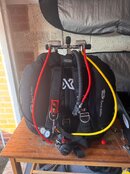50BarBill
Registered
Hello all, just set up my first twinset. And as usual you immediately look into other gear.
What’s everyone’s thoughts on running a drysuit inflation bottle when I typically dive air and soon more nitrox.
In my mind having a separate way to inflate my drysuit in the case of a complete manifold failure would be a good safety aspect, along with being able to gas plan more accurately by removing the usage of direct twinset suit inflation? Mostly online I’ve seen people use them prominently on CCR or at the least trimix diving to save on expensive gases.
Obviously I know I could do it, but the question is should I.
I’ll add a picture of my set up for those who enjoy photos.
Cheers.
What’s everyone’s thoughts on running a drysuit inflation bottle when I typically dive air and soon more nitrox.
In my mind having a separate way to inflate my drysuit in the case of a complete manifold failure would be a good safety aspect, along with being able to gas plan more accurately by removing the usage of direct twinset suit inflation? Mostly online I’ve seen people use them prominently on CCR or at the least trimix diving to save on expensive gases.
Obviously I know I could do it, but the question is should I.
I’ll add a picture of my set up for those who enjoy photos.
Cheers.





